English Toffee: Temperatures for Flavor and Texture
There is something wonderful about the absolutely shattering crunch of toffee. The high-volume bite alone is enough to keep you snacking on a bowl of this confection, but when it’s combined with buttery, caramelly flavor with just a tinge of salt and bitterness it becomes positively irresistible.
Candy making is one of the greatest examples of kitchen alchemy that you can do, and that seemingly magical transformation scares many people off. But with modern tools like the Thermapen®, there’s no reason to fear
For instruction on toffee, we’ve turned to none other than Thomas Keller and his book, Buchon Bakery. His almond toffee is an amazing addition to your winter cookery.
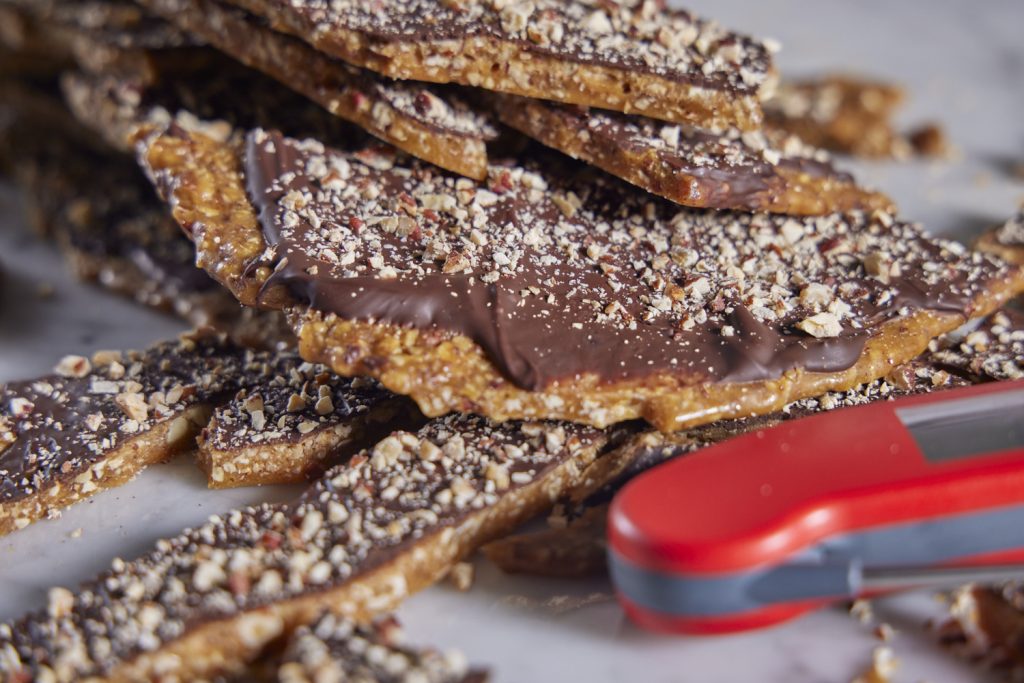
Toffee basics
Toffee is a hard candy made by cooking a sugar syrup with butter to the hard crack stage, 300–310°F (149–154°C), and then pouring it out to cool. It can have inclusions or not, and it can be made either very dense and hard or can be lightened by adding baking soda when the candy is almost done
“English toffee”
In the United States we often refer to “English toffee,” which, of course, they don’t do in England. While the term doesn’t have an exact meaning, it generally refers to toffee that has almonds mixed into it. In that sense, what we’ll be talking about here is English toffee, but you can just as well omit the nuts if you don’t like them or if you are allergic.
Difference between toffee and brittle
Speaking of which, what’s the difference between brittle and toffee? They are very close cousins, especially when you choose to mix nuts into your toffee. Both are heated to the hard-crack stage, and most toffee is lightened by the addition of baking soda, just like brittle is. So what’s the difference? The butter and the order of cooking.
Butter is used heavily in toffee but only sparingly (if at all) brittle, and that accounts for almost all the differences. At the high heat of candy making, the solids in the butter brown and take on a nuttier-toastier flavor and can also contribute to a deeper color. The fat from the butter makes toffee richer.
The order of cooking also makes a difference. In cooking brittle, the baking soda is added right before the candy is poured, while toffee is cooked longer after the soda is added. This lets much of the carbon dioxide escape, leaving the toffee less brittle. In the end, they are cooked in much the same way, but with a few key differences. And, oh! What a difference those changes make!
Toffee temperatures
As with all candy making, temperature control is absolutely essential. The difference between candy stages is narrower than the accuracy of many thermometers, but not the Thermapen! With an accuracy of ±0.7°F (±0.4°C), the ThermoWorks thermocouple technology can handle the fast-changing temperatures of candy making with precision.
Candy Temperature Chart
| Stage | Temperature | Sugar concentration | Common uses |
|---|---|---|---|
| Thread | 230°-234°F | 80% sugar | thick syrup |
| Soft-ball | 235°-240°F | 85% sugar | fudge |
| Firm-ball | 245°-249°F | 87% sugar | caramels |
| Hard-ball | 250°-265°F | 92% sugar | divinity, nougat |
| Soft-crack | 270°-290°F | 95% sugar | saltwater taffy |
| Hard-crack | 300°-310°F | 99% sugar | toffee, brittles |
| Caramel | 320°-350°F | 100% sugar | varying colors and flavors of caramel |
This toffee is cooked initially to 310°F (154°C), then the salt and baking soda are added, creating carbon dioxide. The foaming and bubbling aerate the candy somewhat, making the texture lighter and the candy easier to bite into. The syrup is then brought to 320°F (160°C), the nuts and vanilla are added, and the candy is poured out and formed.
Altitude adjustments
All candy recipes need to be adjusted for altitude. Because of how water reacts to atmospheric pressure, sugar boiling temperatures need to be reduced by 2°F (1.1°C) for every 1,000 ft above sea level you are cooking. In the images below, you will see that we are using different temperatures on our thermometers than in the instructions. That is because we are cooking well above sea level in the ThermoWorks kitchen.
Chocolate tempering
To cover the toffee with chocolate, you first need to temper the chocolate. We’ve written about chocolate tempering before, and I refer you to that post for deeper instruction. If you don’t temper the chocolate, it will bloom (get white and chalky) and melt too easily, so it’s worth the extra effort to temper the chocolate properly.
In the recipe below, we only put chocolate on one side of the toffee. If you want to coat both sides of the toffee with chocolate, double the amount of chocolate. Once it is properly tempered, spread half of it on a sheet of parchment paper, then apply the sheet, face-down, to the slab of toffee. Press on it to ensure contact with the candy. The whole thing can then be inverted so that it is laying on the chocolatey parchment and the rest of the chocolate can be poured on top of the toffee and spread out.
Note: In Bouchon Bakery, Thomas Keller recommends covering the pool of candy with a silicone baking mat or a piece of parchment and using a rolling pin to flatten it out. This works so much better than trying to smooth the candy out with a spatula!
English Toffee Recipe
Adapted from Buchon Bakery, by Thomas Keller
Ingredients
- 2 ½ C skin-on whole almonds (you can substitute other nuts, if you like)
- 10 ½ Tbsp unsalted butter
- 1 ¾ C + 2 Tbsp granulated sugar
- 3 ½ oz water
- 3 Tbsp +2 tsp light corn syrup
- 1 tsp baking soda
- 1 ½ tsp kosher salt
- 1 tsp vanilla paste (or vanilla extract)
- 4 oz good-quality dark chocolate, chopped (optional)
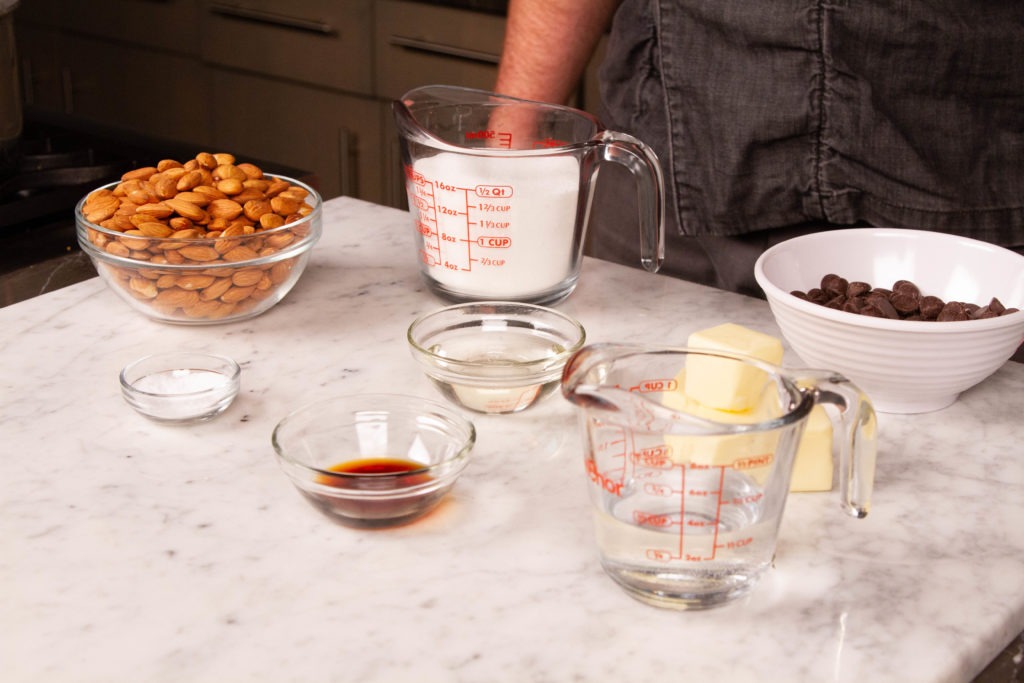
Instructions
Toast the nuts
- Preheat your oven to 350°F (177°C)
- Toast the nuts by spreading them all on a baking sheet and baking them for about 10 minutes (use a TimeStick® to track the time), until fragrant and slightly browned.

- Coarsely chop 2 ¼ cups of the nuts and set aside. Finely chop the rest of the nuts.
Make the candy
- Melt the butter in a large, heavy-bottomed saucepan over medium heat. Stir in the sugar, water, and corn syrup. Stir just to combine, then brush down the sides of the pot with a wet pastry brush.

- Cook until a Thermapen® held in the boiling sugar reads 310°F (154°C)—adjusted for elevation by subtracting 2°F (1.2°C) for every 1,000ft above sea level you are cooking.
- Stir in the baking soda and salt. Be careful! The sugar will foam up when you do this.
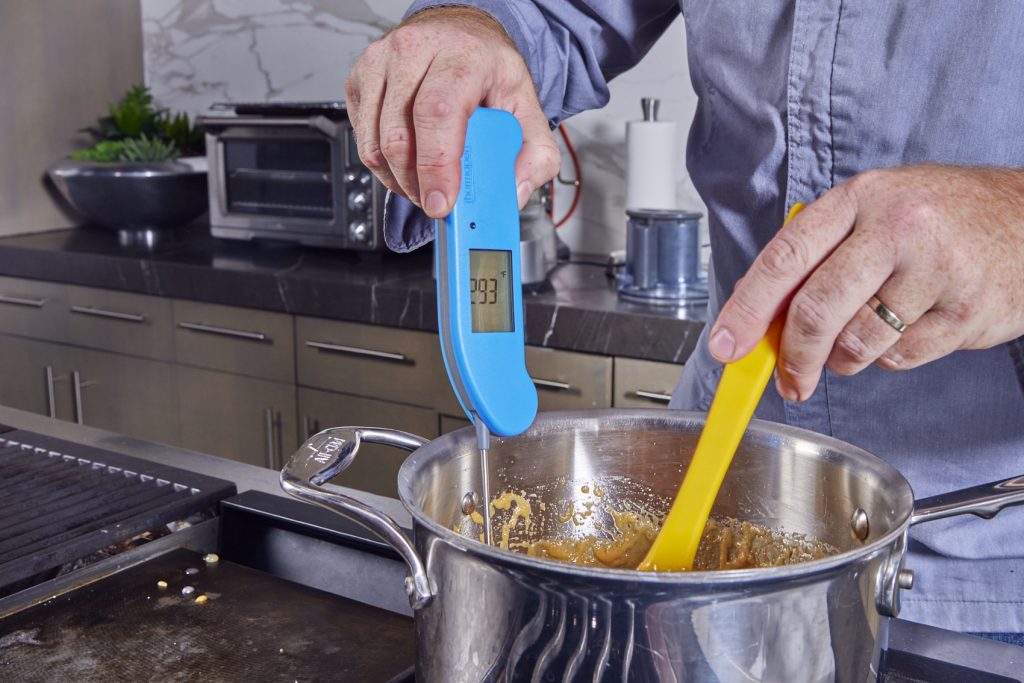
- Continue to cook the syrup to 320°F (160°C), also adjusted for elevation.
- Take the pan off of the heat and stir in the coarsely chopped nuts and the vanilla.

- Pour the mixture out onto a silicone baking mat or a greased marble slab
. Cover the candy with another silicone mat or a piece of parchment paper.- Use a rolling pin to roll the candy out flat. Let cool completely.

Temper the chocolate
- If you are coating the toffee with chocolate, melt 2/3 of the chocolate in a double boiler until it reaches 131–136°F (55-58°C).

- Remove the pot from heat and add the last third of the chocolate. Let it sit in the melted chocolate for a few minutes to slowly melt on its own.
- Stir the chocolate and let cool to 82–84°F (28–29°C), stirring occasionally.

- Reheat the chocolate in a double boiler until it reaches 88–90°F (31–32°C).
- Remove the chocolate from heat and pour it onto the cooled toffee. Sprinkle on the finely chopped nuts.

- Let the chocolate harden completely, preferably in a cool room. (This may take a long time)
- Once the chocolate has set, break it up with a rolling pin.

- Serve or save in an airtight tin or container at room temperature for up to a month.
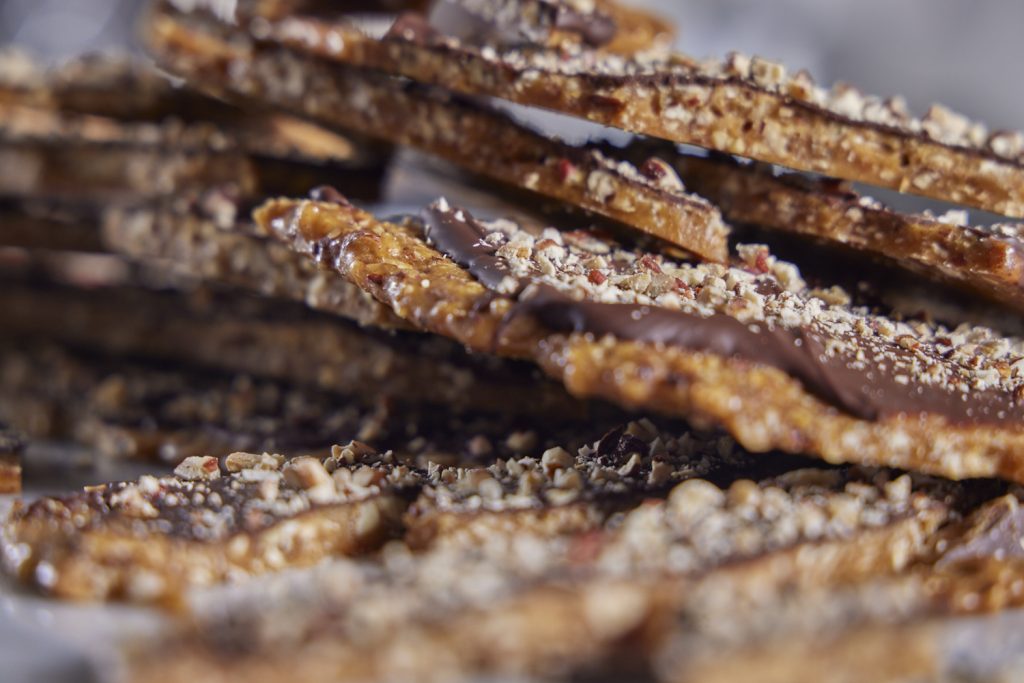
With the help of the Thermapen, making delicious toffee for the holidays—or anytime!—is a cinch. Follow the temperatures and the candy comes together easily. So make up a batch for last-minute parties or distribute it to friends. If you’ve always been scared off by candy making, let this be the gateway recipe to years of sugary success!
Shop now for products used in this post:


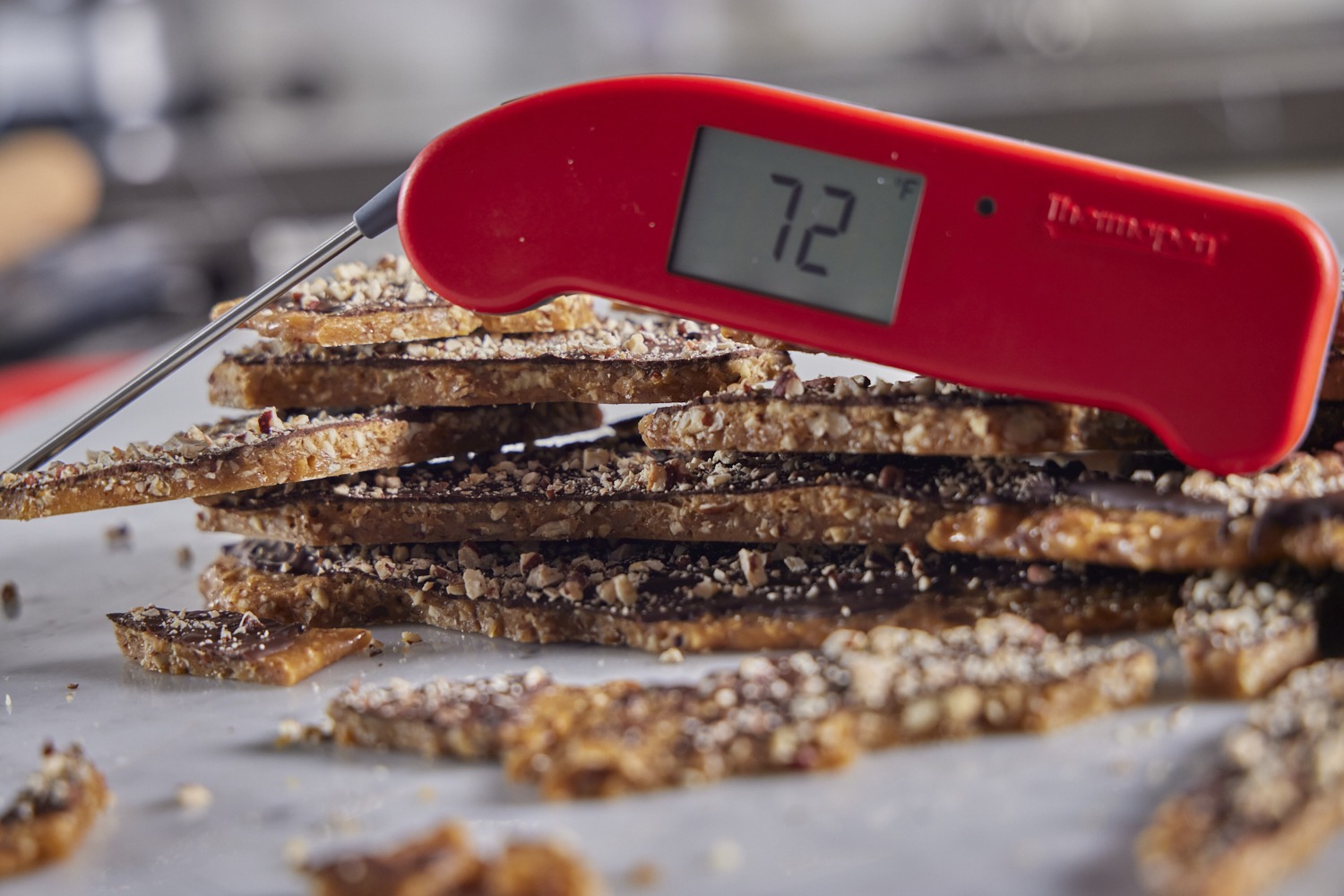

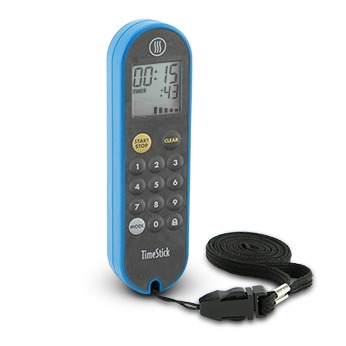
I noticed the temperatures listed on your candy chart I found on the internet are different than what I see in this recipe. The internet chart has toffee in the soft crack area and this recipe definitely takes it to the hard crack and to the light Carmel column on the internet chart at 320 degrees. Pretty confusing for the new learner. I just bought a Chef Mate ThermoWorks temperature unit that I plan to use to make toffee for Christmas gifts. I must admit, that 320 thing is a bit scary. Wish me luck………… Elizabeth Morrison
Yes, it seems odd, but without cooking it to that higher temperature it will taste more like sugar than toffee. Be sure to adjust for your elevation, though! Subtract 1°F for every 500 ft elevation.
Terrible…very hard and not brittle or “melt in my mouth” as described and the reason for trying this recipe. Way too salty, tastes overcooked and not at all buttery. Followed directions implicitly; ended up throwing the whole batch out. Glad I didn’t waste my good chocolate on it.
Sorry it turned out that way for you, it’s delicious every time I make it!
Absolutely perfect for me, using a Chef probe clipped on the side of the pot. The only change I make is using fewer almonds and sprinkling the top with Maldon salt.
You may need to try again. Did you adjust for elevation?
I’ve made many batches of English Toffee with great success, then I stopped for a couple years, and now I’m seeing problems with texture. My toffee always had this crunch, then a rapid melt in the mouth. I started having problems with the rapid melt not being reliable now. I followed a different recipe today that had no water, just butter sugar and salt. The big difference is it specified a 285f temperature. I nervously brought it up to a 290 peak, but held it just above 285 for several minutes. I have a better rapid melt now, but it isn’t perfect. I’ll advance the temperature up some, to see if it gets better. Last year I made 4 batches, running 315 to 320, and the hotter I went the worse the texture went. Now I’m not adding the baking soda, never have, but I’ll try that next just in case the co2 bubbles will further improve the texture. For many years I was using either no thermometer, or one of the glass encased liquid bulb thermometer… My problems seemed to start when I got better thermometers, so it makes me wonder if trying to be precise worked against me this time. Usually precision makes things better, but I supposed you need complete information on the sugar cooking chemistry too.
Your article covered some of the technical details, which I much appreciate. I’ll try to post back if I solve my problem in a repeatable manner…
How about a good dark chocolate molasses puff recipe?
That’s a great idea, I’ll have to see if we can work it in sometime!
I’m completely bemused by articles saying English toffee has to be hard. That’s not the case at all. Toffee in England just means a sweet usually wrapped in paper of some kind. Any flavour can be a toffee. Fruit or caramel toffee can be hard or soft. Hard toffee used to be called “Plot toffee” and was often homemade on 5th November on “Plot night” or “Gunpowder plot” – in recent years the Government has banned traditional Bonfires and Plot night has changed a lot. In Victorian cookbooks the terms “taffy” and “toffee” were interchangeable and meant the same thing. In recent years the term “a toffee” has fallen from use by young people – whereas 20 years ago and back from there everyone would ask “Do you have any toffees”. This could be any small sweets any flavour individually wrapped.
I’ve made this recipe many times with great success using a Chef Alarm or SMoke thermometer…the friends i give it to are telling me they are eating it without hardly stopping it’s so good, comparing to an addict and crack! but the bottom line? It is very good, an extremely easy to follow recipe…I use pecans, always and never bother topping with chocolate!!! In my view, the candy stands tall by itself! Thanks for sharing!
Fantastic!
You’ve made simple butter crunch into something very complicated.
Yield: ~1.5 pounds of butter crunch toffee — AKA Christmas Crack
1 Over medium heat in a heavy saucepan melt then simmer 3 sticks salted butter, 1 1/2 cups sugar, and 2 Tbsp water.
2 When it becomes the color of peanut butter (use a jar as a visual reference) and starts to smoke pour it over a 11″x14″ bed of lightly salted nuts (~ 2-3 cups).
3 While still hot put one cup of chocolate melts (or tempered chocolate) on top. Spread and smooth it.
4 Cool and mature for several hours before breaking it into portions.
No more complex toffee recipes. I found this quick uncomplicated recipe is foolproof. And in my home kitchen in 1 week I crank out 30 batches as Christmas presents. My friends and relatives call it “Christmas Crack”, ask for extra batches, and request the recipe.
Retired Chef
Sounds delicious, too!